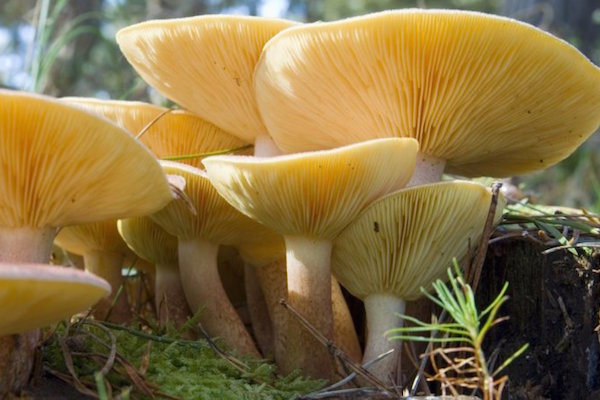Whether it’s setting up a distributed network or devising the best way to share resources, businesses are learning that the natural world has a lot of these things figured out.
New take on an old joke, right? But it really happened. These three were just a few of a diverse set of participants who took part in the first-ever training linking social innovation and biomimicry.
The practice of looking to emulate nature for innovation and sustainable solutions (a.k.a. biomimicry) has been on the rise for decades. Since the 1997 publication of Janine Benyus’s seminal book Biomimicry: Innovation Inspired by Nature, the methodology has especially taken root in the fields of design, architecture, and engineering. There are hundreds of biomimetic examples–like the bullet train that borrows the aerodynamic form of a kingfisher’s beak; or non-toxic adhesives inspired by blue mussels.
 Now biomimicry is taking root in social innovation and could no doubt be adaptable in organizational behavior more generally. It’s not just about nature’s “design.” The living world also has much to teach us about adaptation, resilience, cooperation, and networked systems that thrive functioning together. What if your company could distribute leadership the way a beehive does, with no central command and control, but instead, simple rules that guide and coordinate individuals to accomplish a complex assignment? Or, what if a nonprofit could function more like a forest, connecting diverse community members, and sharing information and nutrients–all part of an intimate and interdependent culture of well-being?
Now biomimicry is taking root in social innovation and could no doubt be adaptable in organizational behavior more generally. It’s not just about nature’s “design.” The living world also has much to teach us about adaptation, resilience, cooperation, and networked systems that thrive functioning together. What if your company could distribute leadership the way a beehive does, with no central command and control, but instead, simple rules that guide and coordinate individuals to accomplish a complex assignment? Or, what if a nonprofit could function more like a forest, connecting diverse community members, and sharing information and nutrients–all part of an intimate and interdependent culture of well-being?
Insights from these types of questions are starting to take root in organizations. The U.S. Green Building Council, for example, drew inspiration from mycelial fungus networks in redesigning its organizational structure to give more autonomy to local chapters while keeping them attuned to the national organization’s mission. Similarly, the government of Alameda County, California, is employing biomimicry’s core lessons–known as life’s principles–in a peer-to-peer pilot program focused on teaching greener behaviors. America Learns, a data management company, opted to forgo its year-end sales push and instead go into a self-imposed “hibernation” to slow down, turn inward, and reconfigure its operations. The following year, the company’s sales increased 20 percent.
We recently led a workshop focused exclusively on applying biomimicry to social challenges. The green consultant, the campaign manager for the National Gay and Lesbian Task Force, and the nun, who coordinates community efforts in Detroit, represented just a slice of the incredible diversity in the group. We also had an entrepreneur, a nature-inspired investment planner, a brand strategist, a husband-and-wife team immersed in conflict resolution for teens, community architects, social and environmental activists, business managers, and several academics.
How would nature organize it?
The first step in the biomimicry methodology, known as biomimicry thinking, is called scoping, which is to identify or quantify the challenge. In design and engineering, this results in questions like “How does nature heat or cool?” “How does nature store energy?” or “How does nature filter water?” But this group scoped different types of challenges. Their questions included “How does nature collaborate and self-organize?” “How does nature evolve networks?” and “How does nature adapt to increasing complexity?”
Next comes the discovering phase, when we look closely to deeply understand the functional strategies that allow organisms to overcome specific, related challenges. Context is key, whether we’re looking to nature for a solution to energy production or employee engagement. And our context was set among the beautiful forest and coastal areas of the Occidental Arts & Ecology Center in Occidental, California. Exploring and examining the grandeur of the redwoods, we found numerous examples of how mutually beneficial relationships in nature coevolve, increase in times of stress, and thrive through reinforcing feedback loops.
Even a single redwood tree is rich with biological intelligence. Group members were amazed to learn that a single tree, after it falls, contributes to the ecosystem for five times longer than it was alive. We imagined how the influence of an 80-year-old activist could extend for 400 years.
We also studied how the savanna/oak chaparral ecosystem developed through processes of succession that adapted as conditions and resources changed. Understanding the critical importance of early successional strategies–markedly different from those in later stages–helped some of the leaders of fledgling entities imagine how roles of employees, and even organizational strategy, would need to adapt over time.
Emulating nature’s organizational genius.
After discovering relevant and inspiring biological examples, the workshop entered the creative phase of biomimicry thinking. Participants learned how to collaboratively create solutions to several hypothetical social challenges, including: How can a 100-year-old advocacy organization change its outreach strategies to reach new constituents? And how might a business scale quickly?
At the end of the week, groups presented solutions that drew on biological examples such as honeybees, DNA, and old-growth forests. While the biological strategies were impressive, the teams discovered that the search for solutions suggested new ways to systemically frame and consider the problems.
One group, for example, presented strategies for a global philanthropic foundation to help its grantees become financially self-reliant over time. Learning from the ecosystem succession processes we observed in the forest, participants advised the foundation to shift its focus from making individual grants to forming connections among its diverse network of grantees. Like adjacent forest organisms that coevolve through stages of increasingly complex and interdependent relationships, the grantees over time could become mutually invested in supporting the well-being of other social enterprises in the foundation’s network. The foundation could then apply its resources to building resilience into the overall health of the system in the way mycelial fungal networks beneath the forest floor link trees, shrubs, and understory plants with necessary nutrients and information.
Sarah Reece, a program director with the National Gay & Lesbian Task Force, brought her own challenge to the workshop. She was inspired by nature’s variation in reproductive strategies and reflected that the task force’s strategic choices in the LGBTQ rights movement, including recent successes in campaigning for marriage equality, have been similar to nature’s variations on reproductive strategies.
Some organisms use what is called an “r” reproductive strategy (r is for rate), producing many seeds or offspring and distributing them widely, banking that some will survive. As with a dandelion, this strategy creates lots of opportunity without investing a lot of energy into any particular seed. Conversely, some organisms, like mammals, use a “K” strategy (from the German word for “capacity,” Kapazität), producing small numbers of offspring and carefully nurturing them with focused attention.
“What I’m seeing about nature-inspired organizing is that if we ask people to do something within their comfort zone, like attend a rally, we can use an r strategy, such as announcing it on social media,” Reece said. “But if we ask them to go out of their comfort zones and do something more risky–like telling their personal stories to legislators, or about being a straight ally to the LGBTQ community–then we need to invest more in training and developing those leaders. That’s a K strategy.”
Life’s principles as leadership practices.
Once a solution is derived from nature’s insights, biomimicry thinking moves into the evaluating stage. This process relies heavily on life’s principles, a set of standard operating procedures observable throughout nature and necessary for creating thriving conditions for future generations. (The ultimate evaluation test!) One can imagine successful solutions might arise, for example, by adapting to changing conditions, cultivating cooperative relationships, and incorporating diversity.
In social innovation, we’ve found that these deep biological patterns are also leadership practices for crafting and then implementing regenerative and sustainable systems. Life’s principles play a critical role for biomimicry and social innovation, as it helps to avoid the wrong application of lessons from individual species. We don’t want to pick one species, like a bee colony, and say, “We should be like them. In fact, I get to be queen bee!” The truth is the queen is not in charge of the hive from the classical hierarchical perspective, and the reality of the context of the hive is very different from our own social organizations.
Instead of mimicking a single species, what we can do as leaders is study and understand the interrelationships in nature, and life’s ubiquitous patterns. Then we can apply those to how we lead change, how we grow our organizations, how we motivate people to think in more systemic, life-affirming ways. Life’s principles are the pathway for that.
Let’s look at feedback loops as an example. We can ask, what are the implications of leveraging feedback loops? How does life do it? How can we implement those processes in our organizations, to bring real-time learning and continual adaptation into improving our results?
Feedback for many organizations consists of annual or quarterly performance reviews. But if you study how nature integrates feedback loops, they’re significantly shorter. Plus, there is tight attunement between the signal and the receiving antenna, resulting in a low signal-to-noise ratio, and much faster aligned response behavior. Nature’s feedback loops foster deeply connected, self-organizing systems that adapt in real time.
From a social innovation perspective, humans need to get better at creating adaptive, thriving systems, given the complexity of the social challenges we face and our need to cooperate in ways we never have before.
We’ve just begun building a network of biomimicry practitioners in social innovation–an ecosystem of inquiry, if you will. With more social innovation workshops coming up, we invite you to become a life-inspired leader. Join us to learn from forests and fungi, humbly listening to their time-tested lessons in sustainability, and practicing in ways that can regenerate our culture, and our planet.
Authors:
Dr. Dayna Baumeister, co-founder of Biomimicry 3.8, has been a business catalyst, educator, researcher, and design consultant for organizations such as Nike, Kimberly-Clark, Kraft, and Boeing, as well as co-director of The Biomimicry Center and professor of practice at Arizona State University.
Toby Herzlich is the founder of Biomimicry for Social Innovation, a network of facilitators, consultants, and thought leaders investigating ways that nature’s wisdom can inform leadership, organizational transformation, and social change. She has worked as a consultant for organizations such as the Sierra Club, the federal Bureau of Land Management, and the National Hispanic Cultural Center.
Source: Inc.
Photo: Getty Images
Diagram:
